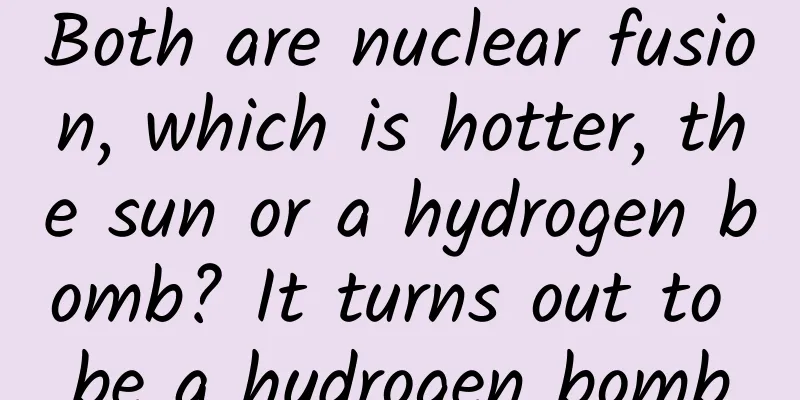Both are nuclear fusion, which is hotter, the sun or a hydrogen bomb? It turns out to be a hydrogen bomb

|
Nuclear fusion, in short, is the process of two light atoms merging into one heavy atom and releasing energy. Why can nuclear fusion generate such a huge amount of energy? Because there will be mass loss in the process of nuclear fusion, and this lost mass will be released in the form of energy. According to the mass-energy equation E=mc², even extremely small mass can be converted into very huge energy, which explains why the energy released by nuclear fusion is so huge. Speaking of nuclear fusion, people will immediately think of two things, one is the sun above our heads, and the other is the hydrogen bomb. So, for both nuclear fusion, which one releases more heat, the sun or the hydrogen bomb? A hydrogen bomb is a nuclear weapon more powerful than an atomic bomb. It releases enormous energy at the moment of explosion and has the terrifying power to raze a city to the ground. However, although the hydrogen bomb is powerful, it is not on the same level as the sun. Not to mention a small hydrogen bomb, even the entire earth is just a small black dot in front of the sun, with a mass of only 1/330,000 of the sun's mass. In this way, the hydrogen bomb seems to be no match for the sun, but in fact the winner of this competition is the hydrogen bomb. The sun is not as hot as we think. When a hydrogen bomb explodes, it will produce a temperature of hundreds of millions of degrees, while the core temperature of the sun is only about 15 million degrees. Why is the temperature of the sun lower than that of a hydrogen bomb? Although the energy of both is generated through nuclear fusion, the nuclear fusion of hydrogen bombs is uncontrollable, and all the energy will be released in an instant. The sun is different. Its nuclear fusion occurs slowly, and this controllable nuclear fusion is exactly the future energy that humans have always wanted. In fact, the 15 million degrees in the core of the sun is not generated by nuclear fusion. In fact, these 15 million degrees are the cause of nuclear fusion. So, before the nuclear fusion started, the core of the sun was 15 million degrees? You can say that. The temperature of the Sun's core is essentially determined by the Sun's mass. When a large enough mass of matter is combined under the action of gravity, it will continue to shrink toward the center. The shrinkage will gradually increase the internal pressure, and the temperature will inevitably rise rapidly under the action of pressure. When the central pressure and temperature of this mass of matter reach certain conditions, nuclear fusion begins. In this case, the temperature of the sun has nothing to do with nuclear fusion? Nuclear fusion occurs only because of high temperature, but it cannot be said that the temperature of the sun has nothing to do with nuclear fusion, because without nuclear fusion, let alone high temperature, the sun itself cannot exist. The sun is constantly shrinking toward the center due to the influence of gravity, and this process will never stop. If there is no nuclear fusion, the sun will continue to collapse toward the center and eventually collapse into a white dwarf, neutron star or black hole through a violent release of energy. Due to the generation of nuclear fusion, the movement of particles inside the sun becomes more violent, which forms a resistance force that is balanced with gravity, thereby preventing the star from continuing to collapse toward the center. At the same time, the heat generated by nuclear fusion also becomes a subsidy for the dissipation of heat radiation inside the star, which allows the star to exist in a stable state. Why can the radiation expansion pressure generated by nuclear fusion just balance the gravity? This is actually very easy to understand. If gravity is stronger than the radiation expansion pressure generated by nuclear fusion, the star will further shrink toward the center, which will cause the temperature inside the sun to rise. The high temperature will make nuclear fusion more intense, and thus balance will be achieved. The same is true in reverse. If nuclear fusion is too intense, the star will expand outward, so the core temperature will drop, and nuclear fusion will slow down, and balance will be achieved again. Of course, nuclear fusion does not change repeatedly inside a star. Once equilibrium is reached, it can be maintained stably until the fuel is exhausted. For more information, please follow the official account: sunmonarch |
>>: Cause of hair loss caused by stress found
Recommend
"Unlimited" data usage is just a gimmick, and it's too early to say Wi-Fi is obsolete
According to arsTECHNICA, a foreign technology me...
Technology News | Guangdong Province achieves “high-speed rail connection between all cities”
【Today’s cover】 Wuyi Mountain in winter is full o...
Google is trying to steal Apple users? It will launch an iOS data migration tool. Apple: We’ve been waiting for you for 5 years
[[414407]] Recently, some netizens discovered a &...
Is bike-sharing out of control? The prisoner's dilemma under the hot topic of the whole nation
"Little guy, do you think I won't recogn...
Build a super detailed AARRR model data indicator system in 5 minutes
The AARRR model is our classic model for user ana...
User retention: How to improve user stickiness?
Do you remember the last time you vowed to stick ...
Mobile phone subsidies are here! @If you are changing your phone, you must read these precautions
The Lunar New Year is coming soon! Have you prepa...
Tractica: Global deep learning software market will reach $67.2 billion in 2025
Deep learning is a buzzword that has received muc...
This makeup habit of girls is secretly bringing tens of thousands of bacteria
A study by Aston University in the UK found that ...
The pain is no less than giving birth! It is recommended that people over 50 years old do this as soon as possible...
This article was reviewed by Wang Ruiyan, MD, ass...
How to implement Android multi-channel statistics without packaging
Abstract: In fact, multi-channel packaging can be...
"People infected with COVID-19 have long-term abnormal lung function"? A secret to debunk this rumor
If you interpret the paper carefully, you will fi...
A woman can only produce 400 eggs in her lifetime? Whoever uses them up first will age first?
I believe many people have heard this saying: wom...
The product aggregation model of the Internet mobile financial platform and the operation model of multi-level users!
This article is of certain value to product manag...
Crack the red envelope algorithm! Why do others always have the best luck?
Audit expert: Zheng Yuanpan Professor of Zhengzho...









